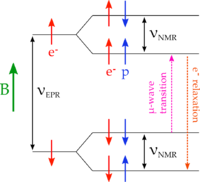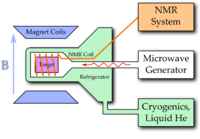Practical Primer on the UVa Target
Contents
Overview
Our Dynamically Nuclear Polarized Target can provide greater than 90% proton polarization in a irradiated ammonia target sample in a 5T magnetic field and at around 1K. The basic operating principle involves leveraging the spin-spin coupling of a free electron in our material to the proton we wish to polarize. In a magnetic field, the spin-spin coupling results in a hyper-fine splitting as see in the diagram to the right.
Using microwaves of wavelengths corresponding to the energy gaps, transitions can be induced to flip to the spin of the proton along with the spin of the electron. As in the example of the dagram, the (down,down) state can be flipped to the (up,up) state, but by changing the microwave frequency it is also possible to flip the (down,up) state to the (up,down) state, thereby anti-aligning the proton without changing the magnetic field. Since the relaxation time of the electron at 1K is on the order of milliseconds, whereas that of the proton is tens of minutes, the same electron can be used to polarize many protons.
DNP
There are 5 basic ingredients which go into this target: a high magnetic field, a low temperature, a microwave system, an NMR system, and a suitable target material. We will briefly walk through these 5 building blocks, and what systems are necessary to provide them in the experimental hall.

